It’s never too soon to start thinking of those spring and summertime problems

A healthy, 3-year-old female was running in her backyard without shoes and impaled her left foot on a nail attached to a board. She was taken to the local ER, where the nail was removed after a radiograph demonstrated that no bone injury was sustained (Figure 1). The patient had documentation of having received her routine 2-, 4- and 6-month immunizations including tetanus, followed by a 4th dose of DTaP at 18 months. She has received no tetanus toxoid since then.
What’s your tetanus prophylaxis?
A. Td
B. Td plus tetanus immunoglobulin
C. DT
D. None
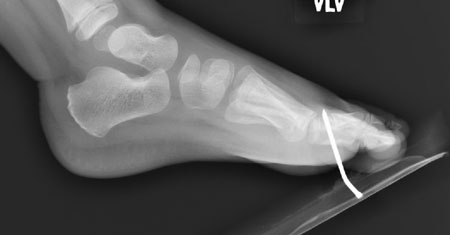

Answer and discussion:
While this is a classic tetanus-prone injury, in this case, the patient is fully immunized for her age (four doses of tetanus toxoid), and it has been less than 5 years since her last dose of tetanus toxoid. Therefore, no prophylaxis is indicated (correct answer: D, None). Additionally, the only time tetanus immunoglobulin is indicated is when a patient sustains a tetanus-prone injury and there is no documentation of the patient having received at least three doses of tetanus toxoid (page 796 of the 2018-2021 AAP Red Book). This problem is usually made more complicated than it should be. I simply remember what I call the “3, 5, 7 and 10 rule” (which I just made up): has the patient had at least three doses of toxoid in their past; has it been more than 5 years since the last dose of toxoid; has it been more than 10 years (for nontetanus-prone injuries) since the last dose of toxoid? Also remember that a patient aged younger than 7 years gets DT (or DTaP), whereas if a catch-up dose is needed for the patient who is at least 7 years of age, then a single dose of Tdap should be used. Otherwise, Tdap is normally given at 11 to 12 years of age, unless the patient received the Tdap at 10 years of age. In that case, the recommended dose at 11 to 12 years would not be needed. Please consult the CDC or Red Book guidelines for more details. If the child is at least 11 years of age, the toxoid should be in the form of a Tdap.
As often happens, a few days later, this puncture wound became infected (Figure 2) and the patient was admitted to the hospital. With no MRI evidence of osteochondritis, a brief course of IV clindamycin was initiated, followed by oral clindamycin for 2 additional weeks with complete resolution. There was no organism recovered, but the majority of these infections are caused by Staphylococcus aureus or group A strep, especially when the infection occurs within a few days of the injury. A variety of Gram-negative bacilli may also be present but are not the major cause of cellulitis. However, osteochondritis is usually caused by Pseudomonas aeruginosa, likely picked up from the insole of the sneaker the child may be wearing at the time of the injury, and it is typically a late-onset infection — many days to even weeks after the injury.
For those of you who read these columns on a regular basis, you are probably recalling a few other cases shown where the question of tetanus prophylaxis was part of the quiz and discussion. Like many mortals, I forget things I previously knew, and need a quick reminder. For some reason, tetanus prophylaxis was one of those questions that I frequently had to look up until it finally broke through the blood-brain barrier.
A classic example that is often seen on the boards is the puncture wound through a sneaker (Figures 3 and 4), which may result in osteochondritis (inflammation involving the cartilage and/or bone in a joint). When seen, it is most likely due to Pseudomonas aeruginosa, and should be empirically covered until the culture result returns. Unlike most osteoarticular infections, with good surgical debridement of the infected area, the total course of antipseudomonal therapy may be as short as 7 to 10 days. Unlike group A strep and some cases of S. aureus (Figures 5 and 6), which manifest the infection in a few days or less as previously noted, Pseudomonas osteochondritis may not become symptomatic for a week or longer, and may present as a dull pain with or without significant swelling.


A previous case appeared in the February 2014 issue, from Michael Cater, MD, describing a child who fell on a roofing nail, lodging the nail in the knee (Figures 7 and 8), which also got infected (Figure 9) and should also be considered tetanus prone.


Some puncture wounds of the foot result in retained foreign bodies; the majority have a port of entry in the forefoot or between the toes, due to the nature of the injury. These injuries usually occur when the child is running on a wooden deck with splinters or other surface with similar objects. So, when the foot swings forward, the object jams into the foot. Sometimes, the child will tell the parent(s) that he got out a splinter, but it gets infected anyway. Believing the story, the provider treats the problem as an uncomplicated infection, and indeed, it may get better. Then the infection recurs. This is virtually always a sign of a retained foreign body, which can usually be seen by a simple ultrasound. I published the first of these foreign body injuries in the January 1990 issue (Figures 10 to 13). In that case, the father insisted that a large splinter was “completely removed.” However, additional material was found in the OR. Sometimes, the path of the splinter can be seen from the appearance of the erythema (Figure 14). An MRSA infection resulted from the injury seen in Figure 15, with no retained foreign body found.
Another case appeared in the May 2016 issue (Figure 16), showing a puncture wound between the toes of a child who ran along a stock (cattle) tank covered with cattle manure. Not telling the parents at the time, he presented with the infection and went to the OR to remove several pieces of a wooden stick (Figures 17-20). Cow manure is a classic source of Clostridium tetani. You cannot get much more “tetanus prone” than a puncture by an object contaminated by cow manure.
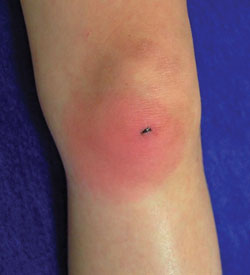
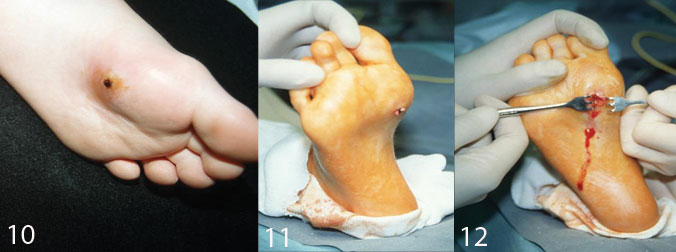





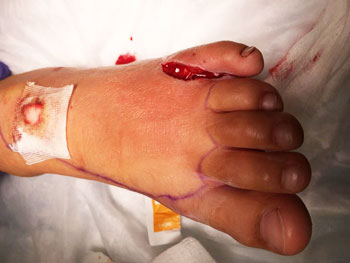
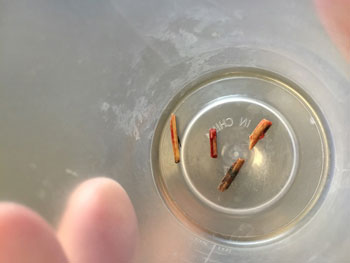
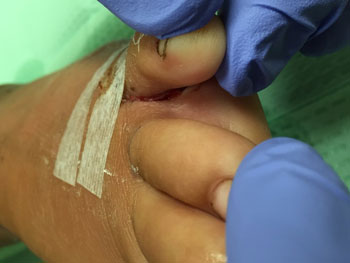
Sometimes the path and even nature of the foreign body is difficult to ascertain without a detailed and accurate history, which is often difficult to obtain from a frightened child in an unwitnessed event. Such was the case presented in the October 2014 column. This was a child who was running in the house, and stepped on a glass aquarium, which broke. When she jerked her foot up, a shard of glass entered the dorsum of the foot (Figures 21 and 22). Two days after the injury, she complained of some pain, erythema and swelling about the head of the 5th metatarsal (Figure 23). An MRI revealed osteomyelitis of the bone (Figure 24), and the culture from the OR grew group A strep. Theoretically, the shard of glass entered at an angle and advanced to the bone, carrying the group A strep along with it.
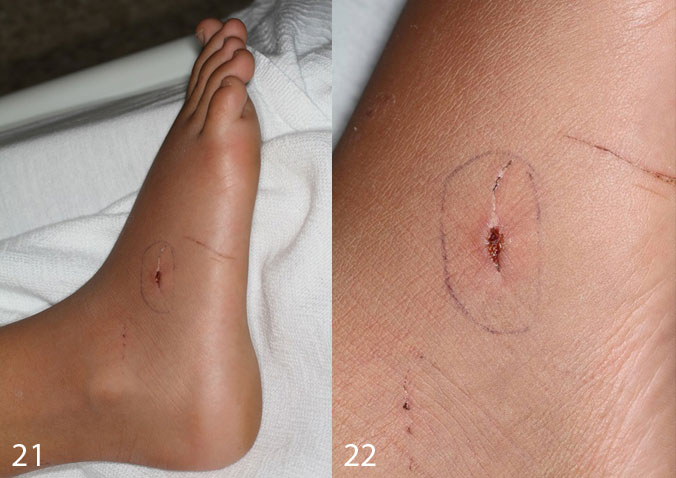
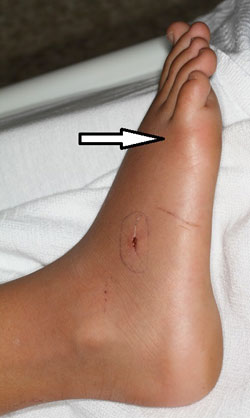
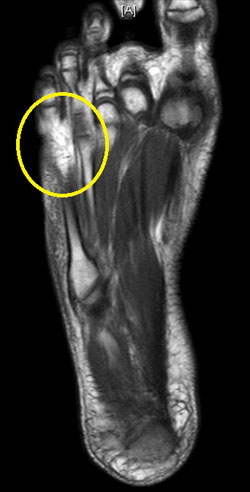
These cases took me back to my childhood, in a flashback to about 5 or 6 years of age, of an incident that occurred when I was testing my newly acquired Superman cape. I jumped from the top of the cab of my father’s drilling rig. I discovered that the law of gravity could not be overcome by simply strapping on an imitation Superman cape. Perhaps if I had the real thing, it may have worked, but instead, my foot found what was likely the only nail in our back yard, where my Dad parked his equipment. Fearing the usual punishment for misbehaving (in this case, playing around by Dad’s equipment), for which my mother was famous for dishing out to me and my older brother (and well-deserved I might add), I chose not to tell her. Instead, I got my shoe off, washed out the blood and hoped all would turn out well. I successfully concealed my antalgic gait, but after a couple of days, my mother told me to get dressed, and I could not get my foot in my shoe. When she saw my swollen foot, she asked in that pre-punishment tone of voice, “What happened to your foot?” Naturally, I denied knowing anything about it. My punishment this time was a trip to Dr. Taylor’s office in Haltom City, Texas, for a tetanus shot, a penicillin shot and a prescription for some gigantic yellow tablets to take four time a day for 10 days. Obviously, I had to chew them, which left a very bad metallic taste in my mouth. My mother, more sympathetic by now, would give me a lemon wedge to suck on afterward, and I took them all.
The teaching points with that scenario are:
A child will take whatever medicine you prescribe if the parent is motivated. This fact was demonstrated by a simple, yet powerful study in the Nov. 6, 1972, issue of JAMA by Colcher and Bass, titled “Penicillin Treatment of Streptococcal Pharyngitis, A Comparison of Schedules and the Role of Specific Counseling.” By simply explaining why it was important to take all the medicine as directed, they raised the compliance rate from 53% to 80%.
The second teaching point is that if a young boy does something that causes injury, he will likely keep it from his parents and his doctor. My mother died at 87 years of age, and I think I told her what really happened to my foot somewhere along the way. However, I made sure I was near the door, as I knew I could outrun her.
- References:
- Colcher IS, Bass JW. JAMA. 1972;doi: 10.1001/jama.1972.03210060015003.
- Kimberlin DW, et al, eds. Red Book: 2018 Report of the Committee on Infectious Diseases, 31st ed. Itasca, IL: AAP; 2018:796.
- For more information:
- James H. Brien, DO, is with the department of infectious diseases at McLane Children’s Hospital, Baylor Scott & White Health, and an adjunct professor of pediatrics at Texas A&M College of Medicine in Temple, Texas. He also is a member of the Infectious Diseases in Children Editorial Board. Brien can be reached at jhbrien@aol.com.
Disclosure: Brien reports no relevant financial disclosures.
